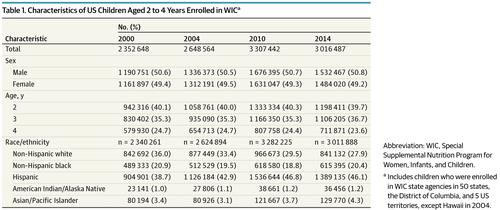当前位置:
X-MOL 学术
›
JAMA Pediatr.
›
论文详情
Our official English website, www.x-mol.net, welcomes your feedback! (Note: you will need to create a separate account there.)
Trends in Severe Obesity Among Children Aged 2 to 4 Years Enrolled in Special Supplemental Nutrition Program for Women, Infants, and Children From 2000 to 2014
JAMA Pediatrics ( IF 26.1 ) Pub Date : 2018-03-01 , DOI: 10.1001/jamapediatrics.2017.4301 Liping Pan 1 , Sohyun Park 1 , Renata Slayton 2 , Alyson B Goodman 1 , Heidi M Blanck 1
JAMA Pediatrics ( IF 26.1 ) Pub Date : 2018-03-01 , DOI: 10.1001/jamapediatrics.2017.4301 Liping Pan 1 , Sohyun Park 1 , Renata Slayton 2 , Alyson B Goodman 1 , Heidi M Blanck 1
Affiliation

|
Importance Severe obesity in childhood is associated with negative health consequences. A previous study examined trends in severe obesity among preschool-aged children in low-income families during 1998 to 2010. No recent trends have been reported. Objective To examine trends in severe obesity by age, sex, and race/ethnicity among enrollees in the Special Supplemental Nutrition Program for Women, Infants, and Children (WIC) aged 2 to 4 years during 2000 to 2014. Design, Setting, and Participants Serial cross-sectional data from 22.6 million young children enrolled in WIC from 50 states, the District of Columbia, and 5 US territories from 2000 to 2014. Data analysis was conducted from February 16, 2017, to March 9, 2017. Main Outcomes and Measures Prevalence of severe obesity. Severe obesity was defined as a sex-specific body mass index-for-age 120% or more of the 95th percentile on the 2000 Centers for Disease Control and Prevention growth charts. Children’s weights and heights were measured. Children whose sex, weight, height, or body mass index was missing or biologically implausible were excluded. Results The prevalence of severe obesity was 1.96% in 2014. During 2000 to 2004, the prevalence increased significantly overall from 1.80% to 2.11% (adjusted prevalence difference [APD], 0.26%) and among all the age, sex, and racial/ethnic groups except for Asian/Pacific Islander (APD, 0.05%-0.54% across groups with increases). The largest relative increase occurred in children aged 4 years (adjusted prevalence ratio [APR], 1.21) and non-Hispanic white (APR, 1.22) and American Indian/Alaska Native children (APR, 1.19). During 2004 to 2010, the prevalence decreased significantly overall (APD, −0.05%), among boys, children aged 2 and 3 years, and non-Hispanic black and Asian/Pacific Islander children (APD, −0.05% to −0.18%). During 2010 to 2014, the prevalence decreased significantly overall from 2.12% to 1.96% (APD, −0.14%) and among all demographic groups (APD, −0.04% to −0.30% across groups). The largest relative decrease occurred in children aged 2 years (APR, 0.88) and Hispanic (APR, 0.92), American Indian/Alaska Native (APR, 0.89), and Asian/Pacific Islander (APR, 0.87) children. Conclusions and Relevance This study provides updated prevalence and trends of severe obesity among young children enrolled in WIC and reports recent modest declines in severe obesity in all subgroups. Ongoing surveillance can assess whether declines continue into the future among low-income children.
中文翻译:

2000 年至 2014 年参加妇女、婴儿和儿童特殊补充营养计划的 2 至 4 岁儿童的严重肥胖趋势
重要性 儿童时期的严重肥胖与负面的健康后果有关。先前的一项研究调查了 1998 年至 2010 年期间低收入家庭学龄前儿童的严重肥胖趋势。没有报告最近的趋势。目的 调查 2000 年至 2014 年 2 至 4 岁妇女、婴儿和儿童特殊补充营养计划 (WIC) 参与者的严重肥胖趋势,按年龄、性别和种族/民族划分。设计、设置和参与者从 2000 年到 2014 年,来自 50 个州、哥伦比亚特区和 5 个美国领土的 2260 万幼儿参加 WIC 的连续横断面数据。数据分析时间为 2017 年 2 月 16 日至 2017 年 3 月 9 日。主要结果和衡量严重肥胖症的患病率。严重肥胖被定义为 2000 年疾病控制和预防中心增长图表上 95% 的性别特定体重指数的 120% 或更多。测量儿童的体重和身高。性别、体重、身高或体重指数缺失或生物学上不可信的儿童被排除在外。结果 2014 年严重肥胖的患病率为 1.96%。2000 年至 2004 年期间,总体患病率从 1.80% 显着增加至 2.11%(调整后的患病率差异 [APD],0.26%),并且在所有年龄、性别和种族/亚裔/太平洋岛民以外的族裔群体(APD,各族群之间增加 0.05%-0.54%)。最大的相对增加发生在 4 岁儿童(调整后患病率 [APR],1.21)和非西班牙裔白人(APR,1.22)和美洲印第安人/阿拉斯加土著儿童(APR,1.19)。2004 年至 2010 年期间,男孩、2 岁和 3 岁儿童以及非西班牙裔黑人和亚洲/太平洋岛民儿童(APD,-0.05% 至 -0.18%)的患病率总体显着下降(APD,-0.05%) . 在 2010 年至 2014 年期间,总体患病率从 2.12% 显着下降至 1.96%(APD,-0.14%),并且在所有人口群体中(APD,各组的 -0.04% 至 -0.30%)。最大的相对下降发生在 2 岁儿童 (APR, 0.88) 和西班牙裔 (APR, 0.92)、美洲印第安人/阿拉斯加原住民 (APR, 0.89) 和亚洲/太平洋岛民 (APR, 0.87) 儿童。结论和相关性 本研究提供了参加 WIC 的幼儿中严重肥胖症的最新流行率和趋势,并报告了最近所有亚组中严重肥胖症的适度下降。
更新日期:2018-03-01
中文翻译:

2000 年至 2014 年参加妇女、婴儿和儿童特殊补充营养计划的 2 至 4 岁儿童的严重肥胖趋势
重要性 儿童时期的严重肥胖与负面的健康后果有关。先前的一项研究调查了 1998 年至 2010 年期间低收入家庭学龄前儿童的严重肥胖趋势。没有报告最近的趋势。目的 调查 2000 年至 2014 年 2 至 4 岁妇女、婴儿和儿童特殊补充营养计划 (WIC) 参与者的严重肥胖趋势,按年龄、性别和种族/民族划分。设计、设置和参与者从 2000 年到 2014 年,来自 50 个州、哥伦比亚特区和 5 个美国领土的 2260 万幼儿参加 WIC 的连续横断面数据。数据分析时间为 2017 年 2 月 16 日至 2017 年 3 月 9 日。主要结果和衡量严重肥胖症的患病率。严重肥胖被定义为 2000 年疾病控制和预防中心增长图表上 95% 的性别特定体重指数的 120% 或更多。测量儿童的体重和身高。性别、体重、身高或体重指数缺失或生物学上不可信的儿童被排除在外。结果 2014 年严重肥胖的患病率为 1.96%。2000 年至 2004 年期间,总体患病率从 1.80% 显着增加至 2.11%(调整后的患病率差异 [APD],0.26%),并且在所有年龄、性别和种族/亚裔/太平洋岛民以外的族裔群体(APD,各族群之间增加 0.05%-0.54%)。最大的相对增加发生在 4 岁儿童(调整后患病率 [APR],1.21)和非西班牙裔白人(APR,1.22)和美洲印第安人/阿拉斯加土著儿童(APR,1.19)。2004 年至 2010 年期间,男孩、2 岁和 3 岁儿童以及非西班牙裔黑人和亚洲/太平洋岛民儿童(APD,-0.05% 至 -0.18%)的患病率总体显着下降(APD,-0.05%) . 在 2010 年至 2014 年期间,总体患病率从 2.12% 显着下降至 1.96%(APD,-0.14%),并且在所有人口群体中(APD,各组的 -0.04% 至 -0.30%)。最大的相对下降发生在 2 岁儿童 (APR, 0.88) 和西班牙裔 (APR, 0.92)、美洲印第安人/阿拉斯加原住民 (APR, 0.89) 和亚洲/太平洋岛民 (APR, 0.87) 儿童。结论和相关性 本研究提供了参加 WIC 的幼儿中严重肥胖症的最新流行率和趋势,并报告了最近所有亚组中严重肥胖症的适度下降。


























 京公网安备 11010802027423号
京公网安备 11010802027423号